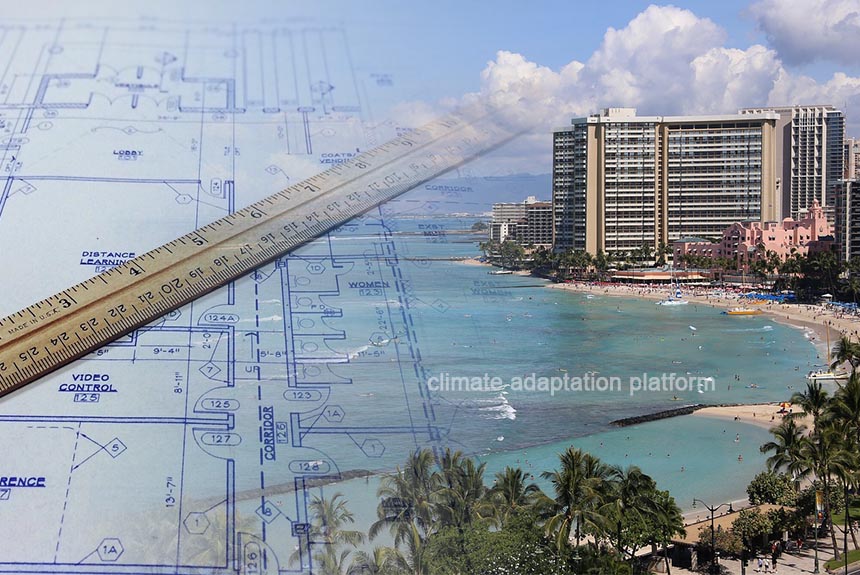Waikīkī is Hawaii’s economic, tourism, hospitality, and cultural hub, contributing $5 billion to the Gross State Product. Although the area is relatively small, encompassing 3.89 km2, it is intensely developed and packed with commercial, residential, and resort beachfront properties.
As a coastal and low-lying area, Waikīkī is threatened by flooding from sea-level rise (SLR) and increases in significant rainfall events from climate change. Specifically, the region faces sea level rise-induced direct marine inundation, storm-drain backflow, and groundwater inundation (GWI), compounded by high-wave runup, extreme tides, heavy rainfall, and a shallow groundwater table. The Army Corps of Engineers estimated a significant flood could damage 3,000 structures and cost more than US$1.14 billion (Van Dyke, 2023).
The study, “A Science and Community-Driven Approach to Illustrating Urban Adaptation to Coastal Flooding to Inform Management Plans”, published in Sustainability in March, and a special issue of Oceanography in April produced architectural renderings of how structures – buildings, utilities, transportation, and open space to visualise sea level rise adaptation strategies.
The goal is to inform communities and increase their awareness of SLR threats and climate adaptation strategies renderings to encourage community engagement and to prepare them for future flooding.
The authors of the study, consisting of an interdisciplinary team from the University of Hawai‘i at Mānoa, say that there is currently no comprehensive guidance on sea level rise adaptation in Waikīkī. Although Honolulu’s first draft climate adaptation strategy, Climate Ready O‘ahu, identifies the desire to retrofit city facilities at risk from storms and flooding, local area plans have not yet defined the implementation timeline, funding, and strategies.
They need guidance for all existing and new buildings and infrastructure to accommodate episodic flooding through 2050 and to prepare for permanent inundation, which will likely happen in 2100.
The renderings show potential flood adaptation options for coastal and open space areas, transportation, utilities and a high-rise mixed-use building.
It illustrates the relocation of critical equipment in buildings and streets, elevation of utilities and walkways, and incorporation of cisterns (water storage tanks) and bioretention areas (soil and plant-based filtration system in a landscaped depression) to manage stormwater runoff. The authors highlight that these strategies could be applied in other low-lying coastal cities facing the same SLR threats worldwide.
The authors used public presentations and online surveys to obtain participants’ views on these climate adaptation strategies’ applicability to Waikīkī. The participants, who came from various backgrounds ranging from landowners, government employees, hotel owners, urban planners, architects, residents, and design professionals, rated each adaptation strategy based on its applicability to Waikīkī for two future periods – 2050 and 2100, from the scale of 1 to 5 – 1 as strongly agree and 5 as strongly disagree.
79% of participants responded that they strongly agree or agree that adaptation strategies were relevant to Waikīkī. The strategies they rated most relevant are relocating critical (building) systems in 2050, elevating critical equipment, and relocating ground-floor use in the 2100 scenario. The exit poll also reveals that 75% of participants strongly agreed or agreed that the discussion increased their knowledge of sea level rise impacts and adaptation strategies.
The research also highlights how academia is vital in addressing public problems like rising sea levels due to climate change.
“The research underscores academia’s role in supporting governmental and municipal efforts to address climate change,” according to Josephine Briones, one of the study’s authors and a UH Mānoa climate adaptation specialist. By providing visualizations and engagement opportunities, the team has helped bridge the gap between scientific research and practical, community-driven solutions (Yamanaka, 2024).
“Academic research plays a pivotal role in illustrating potential future adaptation strategies in low-lying coastal communities and enhances local municipalities’ adaptation plans. Now that we have the resources like these renderings or adaptation strategies and also these reports from our stakeholders, the city can now reference it,” she adds (Yamanaka, 2024).
Sources:
Van Dyke, M. (2023, March 30). University of Hawaii study examines adaptive strategies for sea-level rise in Waikiki. Retrieved from https://spectrumlocalnews.com/hi/hawaii/news/2023/03/30/university-of-hawaii-study-examines-adaptive-strategies-for-sea-level-rise-in-waikiki
Meguro, W., C.H. Fletcher, J. Briones, E. Teeples, and G. Casey. 2024. A visionary approach to advancing sea level rise adaptation in an urban coastal community, Waikīkī, Hawai‘i. Oceanography 37(1):122–123, https://doi.org/10.5670/oceanog.2024.223.
Meguro W, Briones J, Failano G, Fletcher CH. A Science and Community-Driven Approach to Illustrating Urban Adaptation to Coastal Flooding to Inform Management Plans. Sustainability. 2024; 16(7):2849. https://doi.org/10.3390/su16072849
Yamanaka, S. (2024, June 12). UH researchers’ architectural designs address sea-level rise in Waikiki. Spectrum News. Retrieved from https://spectrumlocalnews.com/hi/hawaii/news/2024/06/12/uh-manoa-researchers-address-sea-level-rise-in-waikiki



Leave a Reply